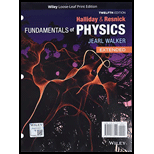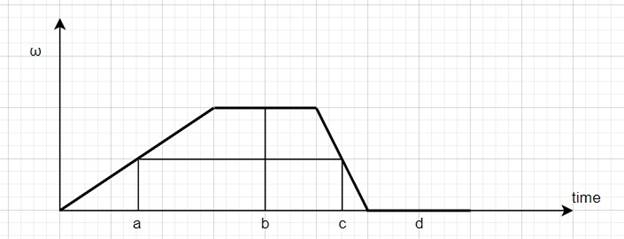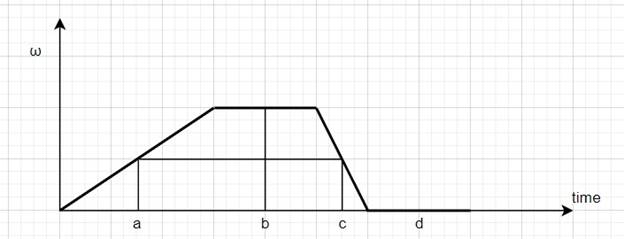
(a)
The comparison of the magnitude of the tangential acceleration for the instances
(a)
Answer to Problem 1Q
The magnitude of the tangential acceleration is maximum at an instant
Explanation of Solution
Given:
A disk rotating like a marry-go table.
And the

Formula used:
The tangential acceleration is directly proportional to the rate of the change in angular velocity and it is written as,
Here
Calculation:
From the given figure,
The angular velocity is constant for instants
The magnitude of the change in angular velocity with respect to the time is more at instant
Hence, the magnitude of the tangential acceleration is maximum at instant
Conclusion:
The magnitude of the tangential acceleration is maximum at instant
(b)
The comparison of the magnitude of the radial acceleration for the instances
(b)
Answer to Problem 1Q
The radial acceleration is maximum at instant
Explanation of Solution
Given:
A disk rotating like a marry-go table.
And the angular velocity vs the time graph is

Formula used:
The radial acceleration is the product of the square of the angular velocity and the radius. So it is written as
Here
Calculation:
Since the radius is constant at every time. Only the angular velocity changes with time.
And the radial acceleration is
Here,
So, more angular velocity means more radial acceleration.
Now the angular velocity at instant
The angular velocity at instant
The angular velocity at instants
Conclusion:
The radial acceleration is maximum at instant
Want to see more full solutions like this?
Chapter 10 Solutions
FUNDAMENTALS OF PHYSICS - EXTENDED
- In testing an automobile tire for proper alignment, a technicianmarks a spot on the tire 0.200 m from the center. He then mountsthe tire in a vertical plane and notes that the radius vector to thespot is at an angle of 35.0 with the horizontal. Starting from rest,the tire is spun rapidly with a constant angular acceleration of 3.00 rad/s2. a. What is the angular speed of the wheel after 4.00 s? b. What is the tangential speed of the spot after 4.00 s? c. What is the magnitude of the total accleration of the spot after 4.00 s?" d. What is the angular position of the spot after 4.00 s?arrow_forwardA disk 8.00 cm in radius rotates at a constant rate of 1200 rev/min about its central axis. Determine (a) its angular speed in radians per second, (b) the tangential speed at a point 3.00 cm from its center, (c) the radial acceleration of a point on the rim, and (d) the total distance a point on the rim moves in 2.00 s.arrow_forwardA point on a rotating turntable 20.0 cm from the center accelerates from rest to a final speed of 0.700 m/s in 1.75 s. At t = 1.25 s, find the magnitude and direction of (a) the radial acceleration, (b) the tangential acceleration, and (c) the total acceleration of the point.arrow_forward
- The propeller of an aircraft accelerates from rest with an angular acceleration = 4t + 6, where is in rad/s2 and t isin seconds. What is the angle in radians through which thepropeller rotates from t = 1.00 s to t = 6.00 s?arrow_forwardJeff, running outside to play, pushes on a swinging door, causing its motion to be briefly described by = t2 + 0.800 t + 2.00,where t is in seconds and is in radians. At t = 0 and at t = 1.50s, what are the a. angular position, b. angular speed, and c. angularacceleration of the door?arrow_forwardDuring a certain time interval, the angular position of a swinging door is described by = 5.00 + 10.0t + 2.00t2, where is in radians and t is in seconds. Determine the angular position, angular speed, and angular acceleration of the door (a) at t = 0 and (b) at t = 3.00 s.arrow_forward
- An ultracentrifuge accelerates from to 100,000 rpm in 2.00 min. (a) What is the average angular acceleration in rad/s2 ? (b) What is the tangential acceleration of a point 9.50 cm from the axis of rotation? (c) What is the centripetal acceleration in m/s2 and multiples of g of this point at full rpm? (d) What is the total distance travelled by a point 9.5 cm from the axis of totation of the ultracentrifuge?arrow_forwardLara is running just outside the circumference of a carousel, looking for her favorite horse to ride, with a constant angular speed of 1.00 rad/s. Just as she spots the horse, one-fourth of the circumference ahead of her, the carousel begins to move, accelerating from rest at 0.050 rad/s2. a. Taking the time when the carousel begins to move as t = 0, when will Lara catch up to the horse? b. Lara mistakenly passes the horse and keeps running at constant angular speed. If the carousel continues to accelerate at the same rate, when will the horse draw even with Lara again?arrow_forwardA uniform rod of length b stands vertically upright on a rough floor and then tips over. What is the rods angular velocity when it hits the floor?arrow_forward
- The tub of a washer goes into its spin cycle, starting from rest and gaining angular speed steadily for 8.00 s, at which time it is turning at 5.00 rev/s. At this point, the person doing the laundry opens the lid, and a safety switch turns off the washer. The tub smoothly slows to rest in 12.0 s. Through how many revolutions does the tub turn while it is in motion?arrow_forwardA car is on a race track of radius 1200 feet. The car begins moving at 118 ft/s, but accelerates at 12.2 ft/s2 up to its top speed, traveling 2510 feet to do so. What is the angular displacement, angular acceleration and initial angular speed of the car about the track?arrow_forwardA disk rotates about an axis through its center. Point A is located on its rim and point B is located exactly one fourth of the way from the center toward the rim. What is the ratio of the angular velocity Wa to that of Wb, and the tangential velocity Va to that of Vb?arrow_forward
 Physics for Scientists and Engineers: Foundations...PhysicsISBN:9781133939146Author:Katz, Debora M.Publisher:Cengage Learning
Physics for Scientists and Engineers: Foundations...PhysicsISBN:9781133939146Author:Katz, Debora M.Publisher:Cengage Learning Principles of Physics: A Calculus-Based TextPhysicsISBN:9781133104261Author:Raymond A. Serway, John W. JewettPublisher:Cengage Learning
Principles of Physics: A Calculus-Based TextPhysicsISBN:9781133104261Author:Raymond A. Serway, John W. JewettPublisher:Cengage Learning University Physics Volume 1PhysicsISBN:9781938168277Author:William Moebs, Samuel J. Ling, Jeff SannyPublisher:OpenStax - Rice University
University Physics Volume 1PhysicsISBN:9781938168277Author:William Moebs, Samuel J. Ling, Jeff SannyPublisher:OpenStax - Rice University Glencoe Physics: Principles and Problems, Student...PhysicsISBN:9780078807213Author:Paul W. ZitzewitzPublisher:Glencoe/McGraw-Hill
Glencoe Physics: Principles and Problems, Student...PhysicsISBN:9780078807213Author:Paul W. ZitzewitzPublisher:Glencoe/McGraw-Hill Classical Dynamics of Particles and SystemsPhysicsISBN:9780534408961Author:Stephen T. Thornton, Jerry B. MarionPublisher:Cengage Learning
Classical Dynamics of Particles and SystemsPhysicsISBN:9780534408961Author:Stephen T. Thornton, Jerry B. MarionPublisher:Cengage Learning




